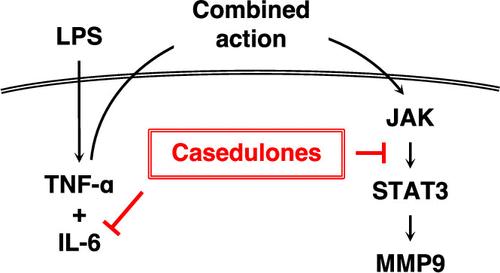当前位置:
X-MOL 学术
›
J. Agric. Food Chem.
›
论文详情
Our official English website, www.x-mol.net, welcomes your feedback! (Note: you will need to create a separate account there.)
Methoxylated Flavones from Casimiroa edulis La Llave Suppress MMP9 Expression via Inhibition of the JAK/STAT3 Pathway and TNFα-Dependent Pathways
Journal of Agricultural and Food Chemistry ( IF 5.7 ) Pub Date : 2024-06-23 , DOI: 10.1021/acs.jafc.4c00965 Tetsuro Kamiya , Nagisa Mizuno , Kaho Hayashi , Tomohiro Otsuka , Manami Haba , Naohito Abe , Masayoshi Oyama , Hirokazu Hara
Journal of Agricultural and Food Chemistry ( IF 5.7 ) Pub Date : 2024-06-23 , DOI: 10.1021/acs.jafc.4c00965 Tetsuro Kamiya , Nagisa Mizuno , Kaho Hayashi , Tomohiro Otsuka , Manami Haba , Naohito Abe , Masayoshi Oyama , Hirokazu Hara

|
Matrix metalloproteinase 9 (MMP9), an MMP isozyme, plays a crucial role in tumor progression by degrading basement membranes. It has therefore been proposed that the pharmacological inhibition of MMP9 expression or activity could inhibit tumor metastasis. We previously isolated two novel methoxylated flavones, casedulones A and B, from the leaves and/or roots of Casimiroa edulis La Llave and determined that these casedulones have antitumor activity that acts via the reduction of MMP9. Here, we examined how these casedulones suppress lipopolysaccharide (LPS)-induced MMP9 expression in human monocytic THP-1 cells. The casedulones suppressed the LPS-induced signal transducer and activator of transcription 3 (STAT3) pathway, which participates in MMP9 induction. In addition, AG490 and S3I-201, inhibitors of Janus kinase (JAK) and STAT3, suppressed LPS-mediated MMP9 induction, suggesting that the casedulones suppressed MMP9 induction through the inhibition of JAK/STAT3 pathways. Based on the findings that cycloheximide, an inhibitor of de novo protein synthesis, completely inhibited LPS-mediated MMP9 induction, the role of de novo proteins in MMP9 induction was further investigated. We found that the casedulones inhibited the induction of interleukin-6 (IL-6), a key inflammatory cytokine that participates in STAT3 activation. Moreover, tumor necrosis factor-α (TNFα)-mediated MMP9 induction was significantly suppressed in the presence of the casedulones. Taken together, these findings suggest that casedulones inhibit the IL-6/STAT3 and TNFα pathways, which all involve LPS-mediated MMP9 induction.
中文翻译:

Casimiroa edulis La Llave 中的甲氧基黄酮通过抑制 JAK/STAT3 途径和 TNFα 依赖性途径来抑制 MMP9 表达
基质金属蛋白酶 9 (MMP9) 是一种 MMP 同工酶,通过降解基底膜在肿瘤进展中发挥着至关重要的作用。因此有人提出通过药理学抑制MMP9表达或活性可以抑制肿瘤转移。我们之前从Casimiroa edulis La Llave 的叶和/或根中分离出两种新型甲氧基化黄酮,卡塞杜酮 A 和 B,并确定这些卡塞杜酮具有通过还原 MMP9 发挥作用的抗肿瘤活性。在这里,我们研究了这些酪蛋白酮如何抑制人单核 THP-1 细胞中脂多糖 (LPS) 诱导的 MMP9 表达。卡杜酮抑制 LPS 诱导的信号转导和转录激活剂 3 (STAT3) 途径,该途径参与 MMP9 诱导。此外,Janus 激酶 (JAK) 和 STAT3 的抑制剂 AG490 和 S3I-201 抑制 LPS 介导的 MMP9 诱导,表明卡杜酮通过抑制 JAK/STAT3 途径抑制 MMP9 诱导。基于de novo蛋白合成抑制剂放线菌酮完全抑制LPS介导的MMP9诱导的发现,进一步研究了de novo蛋白在MMP9诱导中的作用。我们发现卡杜酮抑制白细胞介素 6 (IL-6) 的诱导,白细胞介素 6 是参与 STAT3 激活的关键炎症细胞因子。此外,在存在卡杜酮的情况下,肿瘤坏死因子-α (TNFα) 介导的 MMP9 诱导被显着抑制。总而言之,这些发现表明卡杜酮抑制 IL-6/STAT3 和 TNFα 途径,这些途径都涉及 LPS 介导的 MMP9 诱导。
更新日期:2024-06-23
中文翻译:

Casimiroa edulis La Llave 中的甲氧基黄酮通过抑制 JAK/STAT3 途径和 TNFα 依赖性途径来抑制 MMP9 表达
基质金属蛋白酶 9 (MMP9) 是一种 MMP 同工酶,通过降解基底膜在肿瘤进展中发挥着至关重要的作用。因此有人提出通过药理学抑制MMP9表达或活性可以抑制肿瘤转移。我们之前从Casimiroa edulis La Llave 的叶和/或根中分离出两种新型甲氧基化黄酮,卡塞杜酮 A 和 B,并确定这些卡塞杜酮具有通过还原 MMP9 发挥作用的抗肿瘤活性。在这里,我们研究了这些酪蛋白酮如何抑制人单核 THP-1 细胞中脂多糖 (LPS) 诱导的 MMP9 表达。卡杜酮抑制 LPS 诱导的信号转导和转录激活剂 3 (STAT3) 途径,该途径参与 MMP9 诱导。此外,Janus 激酶 (JAK) 和 STAT3 的抑制剂 AG490 和 S3I-201 抑制 LPS 介导的 MMP9 诱导,表明卡杜酮通过抑制 JAK/STAT3 途径抑制 MMP9 诱导。基于de novo蛋白合成抑制剂放线菌酮完全抑制LPS介导的MMP9诱导的发现,进一步研究了de novo蛋白在MMP9诱导中的作用。我们发现卡杜酮抑制白细胞介素 6 (IL-6) 的诱导,白细胞介素 6 是参与 STAT3 激活的关键炎症细胞因子。此外,在存在卡杜酮的情况下,肿瘤坏死因子-α (TNFα) 介导的 MMP9 诱导被显着抑制。总而言之,这些发现表明卡杜酮抑制 IL-6/STAT3 和 TNFα 途径,这些途径都涉及 LPS 介导的 MMP9 诱导。
















































 京公网安备 11010802027423号
京公网安备 11010802027423号